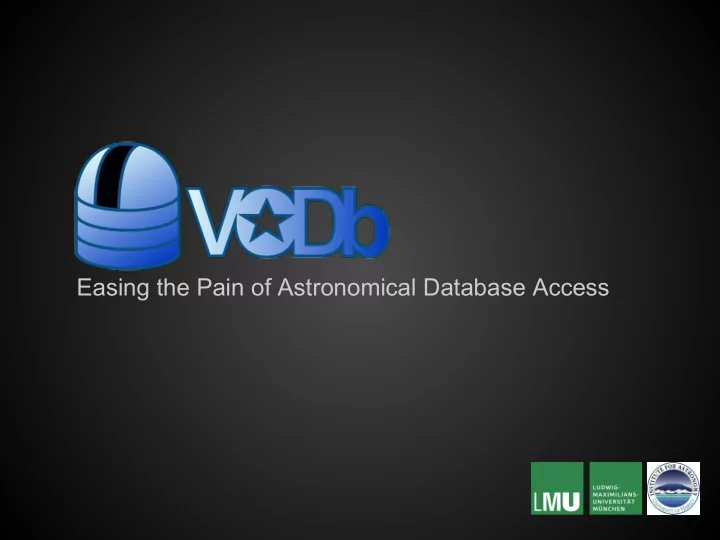

Easing the Pain of Astronomical Database Access
Disclaimer: I usually present this software to non VO-savvy people
What is VODb? A desktop application that aims to simplify the process of querying astronomical databases
A little history ● Started life as part of the Pan-STARRS project ● Pan-STARRS has a lot of data* and a complex schema ● Difficult for the novice to retrieve any meaningful data ● (Difficult for experts to retrieve any meaningful data) ● Many queries would never complete * time-domain; 150 billion detections; 5.5 billion sources; >10xSDSS in first year
Existing web interface ● Pan-STARRS has an SDSS-like web interface ● Offers a query box and a basic query builder but... ● Web-pages offer limited functionality ● Results need to be manually downloaded... ● ...then loaded into a desktop application for analysis
Objectives of VODb ● To make it easier to generate SQL ● To utilise existing VO software to analyse the results ● To provide the ability to work on data offline In short: to enable science
Aren't there exisiting VO database access tools?
Yes, but... Tools like (the excellent) TOPCAT enable database querying as an extra . VODb is a dedicated astronomical database access tool that tries to apply the UNIX philosophy of: "Do one thing and do it well"
Nearly ideal, but... ● Can't connect to Pan-STARRS (or other non-TAP Dbs) ● Doesn't provide the higher level abstraction we wanted ● We wanted a more 'fancy' drag 'n drop query builder
What's so difficult about SQL?
Lots of things are difficult about SQL ● SQL is a programming language (an ancient one) ● Not all astronomers are programmers ● Standardised, but too late: dozens of dialects ● Most vendors don't support the entire standard ● Most vendors diverge from the standard (eg date/time) ● Vendors have an incentive to remain non-standard
But it's declarative , which is good... ● In theory we should just ask for what we want ● We should not have to specify how to get it but... ● Bad performance often enforces an imperative approach ● Requires users to have knowledge of the implementation This is definitely bad
But we're stuck with SQL so...
Simplify the process whenever we can ● Whenever possible, create an abstraction layer so that knowledge of the schema, indexes, keys, partitioning etc is not necessary ● When it is necessary to write SQL directly, provide as much help as possible (user-friendly GUIs)
What data can you access? ● Any local JDBC-supported database ● Any remote TAP database (SDSS, 2MASS etc) ● Pan-STARRS (registered users only) ● A local Derby database to store results ● Design allows new connection types to be added easily
VO compliant ● SAMP ● VOTable ● Table Access Protocol (TAP)
Some features
A user-friendly double-click desktop application
A straightforward, searchable connection manager
SQL syntax highlighting and other text editing conveniences
Drag 'n drop graphical query builder
Astronomical date/time and coordinate converters
Mask generator e.g. for SDSS data quality flags
SAMP communication (pass data to TOPCAT etc)
Local Derby database including full query history
Query diagnostics to help users understand why they waited so long
But those features still require writing SQL
What are plug-in queries? ● Think of them as sophisticated sample queries ● (SDSS and PS: the “20 queries” design methodology) ● Curated online (in XML) for instant deployment ● Available through menus ● Delivered as user-friendly GUIs ● Constrained parameters reduce errors ● Default values enable quick, successful queries
Plug-in queries
Why plug-in queries? ● Using a query builder requires a thorough knowledge of the schema ● Sample queries are helpful, but cumbersome (copy-and- paste, edit)
Example plug-in query XML <query> <author>Millenium</author> <title>Tully-Fisher relation </title> <shortDescription> Find the Tully-Fisher relation... </shortDescription> <longDescription> Find the Tully-Fisher relation, Mag vs Vvir, for galaxies with a bulge/total mass ratio less than a given value </longDescription> <param> <name> PARAM_BULGE_MASS_RATIO </name> <description> Bulge/total mass ratio </description> <type> float</type> <max> 1</max> <min> 0</min> <default> 0.1</default> </param> <param> <name> PARAM_SNAPNUM </name> <description> Snapnum (redshift) </description> <type> int</type> <max> 63</max> <min> 0</min> <default> 41</default> </param> <sql>SELECT vVir, mag_b, mag_v, mag_i, mag_r, mag_k FROM millimil.DeLucia2006a WHERE (bulgeMass < PARAM_BULGE_MASS_RATIO*stellarMass OR bulgeMass IS NULL) AND snapnum = PARAM_SNAPNUM </sql> </query>
Learning by example ● It's difficult to write good SQL ● Plug-ins allow quick, successful querying ● Allow users to adapt, enhance and learn by example ● Help users improve SQL skills ● Help users and become familiar with schema
VODb key principle: Abstraction Astronomers shouldn't have to worry about: ● Database implementation (indexing, partitioning etc) ● File formats (FITS, csv, VOTable etc) ● Connection types (TAP, JDBC, Casjobs etc) These are distractions from the science...
VODb key principle: Abstraction Instead: ● Users given a list of databases with meaningful names ● Users do not interact with any files ● Reduced need to understand the peculiarities of SQL
Some users ● Popular with Pan-STARRS users ● Some interest from LSST and VAO ● Interest from Millennium simulation database ● Possibility to use with Euclid prototype archive
http://goo.gl/4X147
Recommend
More recommend